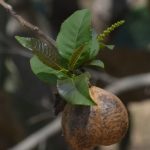TREE LIFE
January 2021
The Chairman and committee wish you all a Happy New Year and may we get in lots of beautiful tree walks this year
January 2nd 2021. Let’s start this year with a wonderful walk through National Botanic Garden starting at 08.30 am. We will meet at the usual place, in the car park, and walk for 1.5 hours. The Chairman hopes to look at the Mahogany species, and anything else of interest, or which there is a lot!!
January 17th 2021. We have been invited by Zia Thomas to visit their beautiful plot at 25 Trafalgar Avenue at 10.00 a.m. You are invited to bring your lunch and picnic. Directions will be given.
February 21st 2021. We are invited by Jan Teede to visit their plot, No. 8, Princess Close, Borrowdale. More details next month.
‘Popular with the birds’: the Albino-berry (TREE OF THE MONTH) Aphloia theiformis
It is used to treat dizziness in the Comoros, cataracts in Mauritius and indigestion in Madagascar.
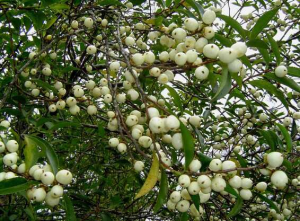
The albino berry in fruit at Nduna Lodge. Photo: Bart Worsten. Source : Flora of Zimbabwe
In Zimbabwe we know it as the Albino-berry on account of its small white berries that festoon its branches like Christmas decorations in December. Aphloia theiformis, as it’s also known, is a small tree or shrub that is common in places like the Vumba. It grows along forest margins and although I was there on a five-day hike in November, I’d never seen one until I got back to Harare.
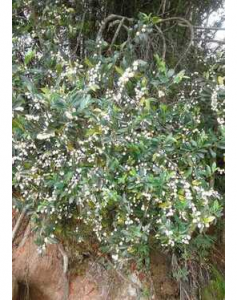
Christmas decorations – the albino berries.
Vumba bird guide and conservation educationist Peter Magosvongwe posted a picture on Facebook of one full of fruit.
He says its berries are a magnet for Livingstone’s turacos, Stripe-cheeked greenbuls and other forest birds while its flowers attract numerous species of butterfly.
The Albino-berry belongs to the Flacourtiaceae family, which includes well-known trees like the Fried-egg flower, Oncoba spinosa; the Batoka plum, Flacourtia indica and the Forest peach, Rawsonia lucida.
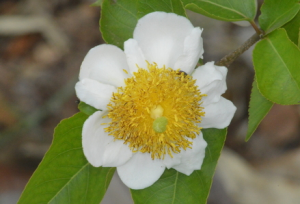
The fried egg flower is a relative of the albino berry. Photo: Ryan Truscott
The latter is another iconic Vumba species. On a hike in 2018 our route took us down the southern slopes of the Vumba beneath towering Fluted milkwoods, Chrysophyllum gorungosanum and Smooth-barked flat-crowns, Albizia gummifera.
I remember how the glossy leaves of the Forest peaches shone in the dark understory as sunlight penetrated the tree canopy. The specific name, lucida, means “shining”.
The Albino-berry plays its own pivotal role in the Vumba ecology.
Also known as the Mountain peach, it seems to favour rocky areas and is a “pioneer in regenerating forest”, according to botanist and former Vumba resident Bart Wursten.
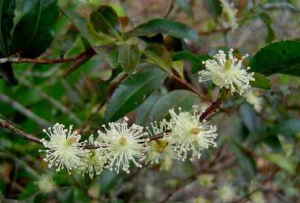
The albino berry flowers between September and November. Photo: Bart Worsten. Source: Flora of Zimbabwe
“The berries certainly are popular with birds and, I believe, also eaten by people sometimes,” he says.
He and his wife had numerous Albino-berries, including a few large ones, growing around their home, Ndundu Lodge.
“We had some forest edges at the boundaries of our property and I encouraged the forest to reoccupy on some patches,” he told me.
“It was likely one of the first species I photographed and the images on the (Flora of Zimbabwe) website were taken with my first, small, digital camera.”
Recent scientific research has verified what sub-Saharan communities, including those on the islands mentioned above, have known for ages: that the plant has very useful medicinal properties.
That’s because the Albino-berry contains something called mangiferin. Mangiferin is described by scientists as a “miracle compound” that has been shown to be effective against “lifestyle related disorders” including obesity and type-2 diabetes.
A study published in 2017 in the journal Biomedicine & Pharmacotherapy said A. theiformis showed “inhibitory activity against some key enzymes linked to obesity, kidney stone formation, Alzheimer’s disease, and hypertension.”
It sounds promising, though the authors stated that more experiments were needed to confirm its effectiveness.
Time, however, may not be on the side of plants like these, or the places where they grow. The Vumba is no exception
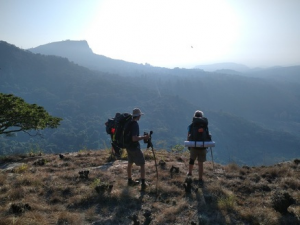
With fellow hikers on the Vumba Trail. Photo: Ron Zee
My hike with friends in November along the 64-kilometre Vumba Trail took us through most parts of this mountain range. Some areas were pristine, but in others slash-and-burn agriculture could be seen slowly eating away at the edges of the evergreen forest.
Locals will tell you that after forests are felled, soils produce good crops for two or three seasons. After that the fertility is exhausted and yields plummet. Abandoned or fallow fields then become quickly infested with the invasive and impenetrable Bee bush, Vernonanthura polyanthes, to the exclusion of everything else.
A way must be found urgently to balance the needs of people while preserving the integrity of Vumba’s evergreen forests.
They are home to unique birds, mammals and reptiles, but they are also home to plants like the Albino-berry that could help treat our illnesses.
It would be a tragedy to lose such a treasure trove of biodiversity.
-Ryan Truscott
Epiphytic Orchids in Zimbabwe (1) some Savannah Epiphytes
Zimbabwe’s orchid flora comprises of about 350 species, only about one quarter of these (95 species) are epiphytes. This imbalance is due to the long dry season which has tended to favour ground orchids during evolution. In addition, in Zimbabwe about 90% of the epiphytic orchid species are found growing only in the Eastern Highlands where they occur in rainfall islands with an annual precipitation of more than 1200 mm. The remaining 10% are called savannah epiphytes. They have strong succulent adaptations which enables them to survive the long dry season on the highveld. Some of these species can be seen quite often in Mashonaland on outings of the Tree Society, mostly flowering at the beginning of the rainy season.
Though epiphytic orchids grow on trees, unlike the Mistletoes they are not parasites. They use trees only as hosts, not as a food source. In addition, they get more light in the tree canopy than what is available on the ground. One of the favourite host trees in Mashonaland is the Musasa, although many species grow on a variety of different tree species. Another peculiarity of orchids are the seeds. They are minute and do not contain any food resources as a ‘starter pack’ for the embryo when germinating. Subsequently orchid seedlings need a ‘nursing aid’ from which to obtain their food. These are mycorrhiza and other fungi. That means, orchid seedlings generally pass through a saprophytic stage. Only when they have developed green leaves, are they able to start producing their own food by photosynthesis.
Orchid flowers are known to be very diverse, but always have the same basic structure, namely 3 sepals and 3 petals. One of the latter (the so-called lip or labellum) is usually modified and often enlarged to work as a landing platform for pollinators. But the most distinctive feature of the orchid flower is the reproductive organ. Unlike most flowers, the pistils and stamens are not developed as separate structures but fused into a combined finger-like structure, the so-called column. In this way orchid flowers become ‘precision flowers’; i.e. they are very selective with regards to their pollinators and can be pollinated only by one or very few insect species, respectively.
The savannah epiphytes
The savannah epiphytes are a small group of about ten or twelve species. Most of these are widespread in the Flora Zambesiaca region and beyond, but confined to areas with an annual rainfall of at least 800 mm – with the exception of Ansellia africana and Microcoelia corallina. The latter can be found growing in areas with only 600 mm. In addition, the savannah epiphytes depend on certain ecological niches for their survival; e.g. riverine forests, thermal belts and certain topographic features where humidity levels are higher during the dry season. It can be seen from the following notes that this group is very diverse and quite interesting, both floristically and ecologically.
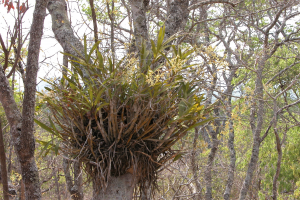
Ansellia africana
Ansellia is a monotypic genus widespread in tropical Africa and South Africa. It can even be found in the lowveld in areas with 600 mm annual rainfall. Where they are found, populations are normally thinly spread over a wide area. Ansellia africana are large plants with cane-like shoots, up to 80 cm in length and 4 cm in diameter. 4-6 leathery leaves are born on the apical half of the canes. Some of the roots grow upright to form a basket in which dry leaves are collected to be processed as compost. The inflorescence emerges from the top of the cane and is always branched, carrying a mass of variable flowers. They are about 3 cm in size and yellow with brown or maroon spots. Ansellia africana grows on a variety of tree species and is widespread in Mashonaland (can be found in the Botanical Gardens). Occasional one can find huge plants in the bush which suggest that they are older than humans. And sometimes Ansellia africana can be seen as a garden plant, attractively arranged growing on tree trunks where they receive plenty of light. Often growing wedged into the fork of a tree; growing in dry low-lying areas on Adansonia digitata, Colophospermum mopane; in higher areas on Brachystegia, Julbernardia, Uapaca, Ficus, Parinari, Terminalia, Balanites aegyptiaca, Burkea africana, Albizia spp.
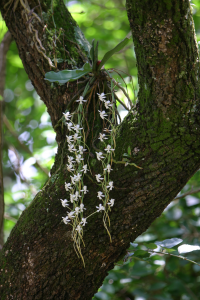
Aerangis verdickii. Photo: Werner Fibeck
Aerangis is a genus of horticultural value and contains about 50 species, widely distributed in tropical Africa and Madagascar. Most species grow in shaded habitats in high rainfall areas. But botany is full of exceptions. Aerangis verdickii being one of these, plants often grow in exposed position. Plants have a short stem, pencil-thick roots and fleshy distichous leaves which, depending on the habitat, may shrivel to a frightening extent during the dry months. Occasionally one can see even plants surviving (and flowering) without leaves.
Plants recover quickly after the first showers. They develop up to 4 inflorescences (20-40 cm long) carrying up to 12 flowers each. They are arranged strictly in 2 rows, are about 3 cm in size and sweet scented at night. Of particular interest are the nectar tubes which are 15-20 cm long as flowers are pollinated by long-tongued hawk moths. This species often grows on Musasa and
Mufuti, but also on other tree species. It is widespread in Mashonaland and, for example, can be seen in Christon Bank and in the Botanical Gardens. They grow on many savannah tree species.
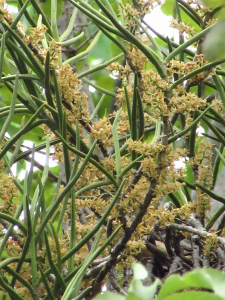
Tridactyle tridentata belongs to a genus of about 40 species widespread in tropical Africa. Stems grow up to 50 cm in height developing dense clumps with increasing age. Again, a well developed root system and terete leaves are adaptations in order to survive the long dry season on the highveld. Plants can be extremely floriferous in certain years and carry a mass of small straw-yellow flowers on short inflorescences along almost the entire stem. This widespread species mostly grows on Musasa trees and can be seen in the Botanical Gardens. They have also been seen on Euphorbias, Combretums and Terminalias.
Tridactyle tridentate
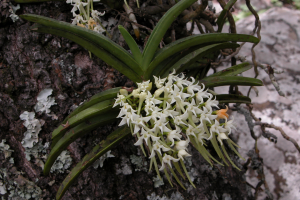
Cyrtorchis praetermissa belongs to a small genus of 15 species. This species grows up to 30 cm high and can develop clumps with increasing age. The stem carries a number of distichous leaves which are folded during the dry season to reduce transpiration. At the beginning of the rainy season plants quickly recover from the stress. They develop 2-4 inflorescences which are up to 10 cm long. Flowers are white and night scented, about 2 cm in size with a tapering nectar tube (2-3 cm long), and strictly arranged in 2 rows. Cyrtorchis praetermissa grows mostly on Musasa and can be seen in Christon Bank and in the Botanical Gardens.
Cytorchis praetermissa
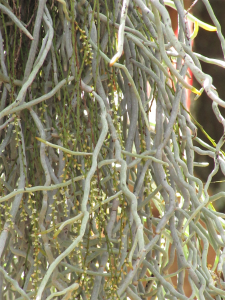
The genus Microcoelia begs to differ, being a leafless genus with about 30 species, occurring in tropical Africa and Madagascar. Leafless epiphytic orchids are rather unusual plants. These are adaptation to dryish climates and intended to reduce transpiration and water loss. Within the orchid family, leafless genera have developed independently on all tropical continents. Having no leaves, photosynthesis takes place in the roots.
At first glance Microcoelia exilis can be mistaken to be some kind of bird nest because it consists of a bundle of air roots, only loosely attached to twigs and branches. Plants develop up to 20 hanging inflorescences (up to 25 cm long) which are densely-many flowered. They are white and only 1-2 mm in size. Although being rare, the species is widespread in Mashonaland and the Eastern Highlands, often occurring in riverine forest. They grow on a wide variety of indigenous trees and even on exotic trees e.g. Jacaranda, Guava, fig and peach. I have only ever seen one orchid growing on an exotic tree – Guava.
Microcoelia exilis
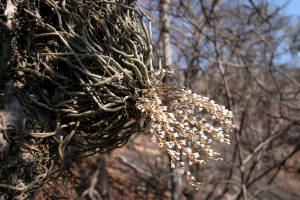 Microcoelia globulosa are compact plants with a short stem and a well developed root system. Where this species is found, it forms large dense populations. Inflorescences are numerous, about 10 cm long with up to 15 small white flowers of a crystalline texture and a brownish centre. They emit a honey scent at night. This species is widespread and are plentiful in Christon Bank where sometimes it can be seen growing on the stems of Euphorbia griseola subsp. mashonica.
Microcoelia globulosa are compact plants with a short stem and a well developed root system. Where this species is found, it forms large dense populations. Inflorescences are numerous, about 10 cm long with up to 15 small white flowers of a crystalline texture and a brownish centre. They emit a honey scent at night. This species is widespread and are plentiful in Christon Bank where sometimes it can be seen growing on the stems of Euphorbia griseola subsp. mashonica.
Microcoelia globulosa
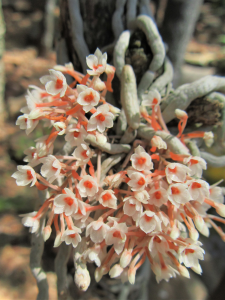
Microcoelia corallina differs with regards to plant size and flower colour. In addition, it differs ecologically because it grows in dry Baobab country, often next to a river. It is a miniature species; fully-grown plants easily fit into an open hand. Roots are numerous and short, 3-4 mm in diameter, clinging to the host and forming a conical tuft. Inflorescences are many and erect, only up to 5 cm high and densely flowered. Flowers are 6 mm in size, salmon-coloured with a deep salmon-red centre. Has been seen growing on riverine trees e.g. stem fruit.
Microcoelia corallina
References
Browning, J. (1978) (ed.): Southern African Epiphytic Orchids by John S. Ball. Conservation Press, Johannesburg
Hyde, M.A.; Wursten, B.T.; Ballings, P. & Coates Palgrave, M. (2020): Flora of Zimbabwe. https://www.zimbabweflora.co.zw
La Croix, I. & Cribb, P.J. (1995, 1998): Orchidaceae. In Pope, G.V. (ed.): Flora Zambesiaca 11(1 & 2). Royal Botanic Gardens, Kew/London
-Werner Fibeck
Trees Planted at 131 Enterprise Road 2002 -2012
This is a 2 acre property, and it was fairly run down when we bought it. My son and daughter in law lived there for a year. During which time we put in a new boundary wall and they made some major alterations to the house. In September 2002 they moved to England with their three daughters, and Jim and I moved into 131.
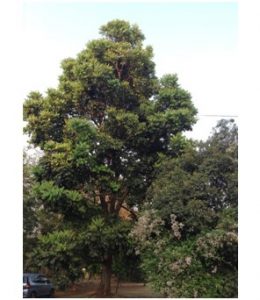
Photo: Ann Sinclair
The garden had some lovely old Msasas, Brachystegia spiciformis, sadly over the years most of them died and there is only one left, but I have saved two self seeded trees. They are now almost 2 meters tall but spindly.
There are several well established trees namely a Podocarpus falcatus, A Stenocarpus sinuatus, the Queensland fire wheel tree. A Delonix regia, the Flamboyant, and the Belhambra tree, Phytolacca dioica. This is a large tree from Argentina it has a very aggressive root system. It flowers profusely with a mass of white catkins in December.
I decided to plant a collection of indigenous trees to fill the rest of a bare garden. Patsy Keevil helped to plan the garden and we used mostly perennials in the flower beds which are easy to maintain, Agapanthus, Dietes and Tulbaghia among others.
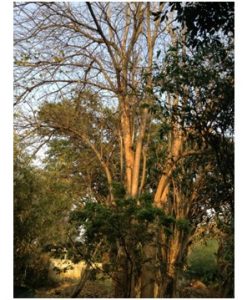
Photo: Ann Sinclair
The early plantings of trees included a Khaya anthotheca, now a handsome tree, Podocarpus falcatus, Olea europaea and Albizia gummifera, this I thankfully planted far from the house. The roots of this tree spread over a wide area and small trees develop from the roots.
Syzygium guineense, the waterberry, the young leaves are purple to red. Euclea natalensis, has very dark leaves and is very slow growing and I am still waiting for it to flower and produce sprays of red to black fruit.
Craibia brevicaudata is a Vumba forest tree, so likes shade, and the white pea flowers are most attractive, but it does attract a mealie bug. Strelitzia nicolai is a handsome plant with large white and blue flowers in a spathe. It grows large and it is a good idea to cut out the old stems as they mature and allow the younger ones to develop.
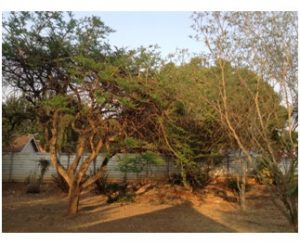
Photo: Ann Sinclair
Oncoba spinosa, is one of my favorite flowers with white petals and mass of yellow stamens in the middle, the fried egg flower tree. It has long thorns hence the name spinosa. Mystroxylon aethiopicum a small attractive compact tree.
Cussonia spicata the cabbage tree from the Eastern Highlands. I love its shape, shaped leaves and angular fruit. Sadly I planted mine too close to other trees and it has grown crooked so has lost the impact of an accent tree. And then came Clausena anisata a small evergreen tree, the leaves have a strong scent, sometimes resembling aniseed. It has attractive flowers and fleshy fruit turning red to black when mature.
An attractive shrub though poisonous is Acokanthera oppositifolia, the Bushmen use the bark and wood for poisoning their arrows.
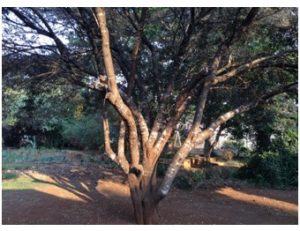
Photo: Ann Sinclair
Dovyalis zeyheri a small tree armed with paired spines up to 3cm long. The fruit is bright orange when mature and can be used to make a tart jelly. Bridelia micrantha is a medium sized tree, the leaves change to autumn colours in September. The fruit is small blackish and sweet tasting, birds spread the seed and we often found self seeded trees in the garden. My original trees came from Meg Coates Palgrave. I told her I was looking for a tree to plant along the road. She said her Bridelia had a mass of seedlings and I was welcome to them. We collected the trees, but I made the mistake of planting them straight out. I should have potted them and given them a chance to grow. Only two survived, this is very sad as they would have made a good border.
Cordia africana is large and fast growing and produces a mass of white flowers in April. It does need some pruning as it can grow out of shape. Celtis africana is a favourite with fresh green leaves in the spring and an attractive bark.
On the west boundary I have a jungle of an Erythrina lysistemon, Combretum paniculatum which has sprays of red flowers in the spring an Oncoba spinosa some aloes including Aloe barberiae the biggest of the Aloe family. Markhamia acuminata, the bean tree, with showy flowers, yellow flecked with maroon, and the fruit is a long capsule. Vepris undulata the white ironwood, Afzelia quanzensis the pod mahogany a beautiful tree, slow growing but so worthwhile, and Mundulea sericea the cork bush with purple to mauve pea flowers.
Acacia sieberiana the flat top spreading Acacia. On the farm we had one which could shade 100 head of cattle. Acacia nigrescens with its knobbly bark.
Combretum hereroense, a small tree with soft leaves shaped like a mouse’s ears. Erythrina abyssinica, this had been in a pot for a long time and was root bound but after several years it has grown into a good looking tree.
Olea europaea the wild olive has grown well near the house, and Trichilia dregeana has done well but needs more space. A Croton megalocarpus a nice shade tree but deciduous and messy when the leaves drop.
I do get great satisfaction when I visit the property and walk round the garden.
Ann Sinclair
Botanic Garden Walk: Saturday, 05 December 2020
Nine members assembled in the Botanic Gardens. We welcomed a visitor, Cathy Sharp, the fungus expert from Bulawayo, who is here in Harare working on a joint project with Meg on Brachystegia.
Today’s session was led by Tony and covered the genus Albizia, sometimes known as False thorns. The generic name comes from an Italian naturalist, Filippo degli Albizzi. Despite the spelling of his name with 2 z’s, the correct spelling of the genus is with one z.
We saw 8 species of albizia; one other species, amara, was too far away in the Gardens to be reached in the time available.
As a rough rule of thumb, these can be grouped according to leaflet width:
- very narrow leaflets (less than 4 mm wide): amara and harveyi
- medium sized leaflets (about 4-8 mm wide): gummifera, schimperiana and zimmermannii
- large leaflets (> 8 mm wide): antunesiana, anthelmintica, glaberrima and versicolor
To start with the small leaflet group, harveyi (the Sickle-leaved albizia) has leaves about 3-4 times as long as wide whereas amara (Bitter albizia) has leaves about 6 times. Both species have a large number of pinnae and leaflet pairs per pinna. The leaflets of harveyi are slightly sickle-shaped whereas those of amara are straight. The bark of harveyi is deeply furrowed and the specimen in the Botanic Gardens is particularly well endowed in this respect. Both species are widespread in Zimbabwe with amara the commoner of the two.
In the medium leaflet group, gummifera (Smooth-bark flat-crown) has rectangular leaflets with the main vein going diagonally across. In the Eastern districts, this may be confused with adianthifolia (Rough-bark flat-crown) which is very similar but has brown-hairy leaves, a rough bark, lacks a prominent “heel” and also occurs at lower altitudes. There is no adianthifolia in the Gardens so we weren’t able to make the comparison. However, gummifera is exceedingly common in Harare’s streets and gardens and adianthifolia also (rarely) occurs as a planted tree. Both species have central flowers which are markedly different to the surrounding ones. Tony discussed these species in the December 2020 Tree Life and presents other points of separation together with images.
A splendid Albizia schimperiana (Forest long-pod albizia) occurs next to the National Herbarium. This tree branches near the base and covers a wide area. The leaflets are asymmetrical and have two distinct veins from the base running across the leaflet. A. zimmermannii (Woodland long-pod albizia) has symmetrical leaflets with one central vein.
Amongst the species with large leaflets, A. versicolor (Poison-pod albizia) has the largest leaves of all. These, unlike any other Zimbabwean species, are softly velvety to the touch and hence easy to recognise. Pods develop on the tree and only mature many months after flowering in the subsequent winter and spring (July – September). These can be attractive to cattle and have led to cases of mass poisoning.
A. anthelmintica, (Worm-cure albizia) is distinctive in having small numbers of pinnae and leaflets and the tip of the rhachis has a downwardly bent hook. Parts of this tree (roots and bark) are an effective measure against tape worms, as the common name suggests.
- antunesiana (Purple-leaved albizia) is probably the most common albizia in the Harare area and one we are familiar with. The leaves are discolorous, paler beneath and are sometimes purple, but the really purple forms are most often seen in very young plants.
- glaberrima (Lowveld albizia) as the name suggests occurs at low altitudes in mopane woodland in the SE of Zimbabwe and would probably not be one that we Harare-based folk would see very often. However, the species is in the horticultural trade and may be seen quite frequently in streets and gardens of Harare. A distinctive feature is the leaflets increase in size and width towards the apex of the leaf in a similar manner to leaflets of the msasa.
At the end, a leaf from each of the 8 species (with one duplication – glaberrima) were laid out on the ground.
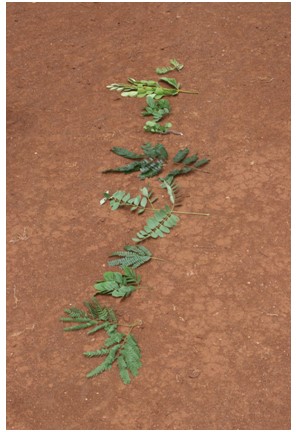
Different types of Albizia Leaves. Photo: Mark Hyde
From the top, in order, the leaves are:
harveyi, versicolor, glaberrima, anthelmintica, gummifera, antunesiana, schimperiana, glaberrima (again) and zimmermannii.
In addition to the studies of Albizia, many plants were flowering and we were side-tracked by a number of these:
Millettia usaramensis, a beautiful purple legume, was in full spectacular flower. Also Sansevieria hallii with its large inflorescences.
The Fried egg flower (Oncoba spinosa) was going great guns and there were some nice-looking flowering shrubs of Combretum obovatum with its white upper leaves and 5-winged fruit.
All in all, it was a very interesting and enjoyable walk. Thanks to Tony for a well-organised meeting.
– Mark Hyde
TONY ALEGRIA CHAIRMAN



